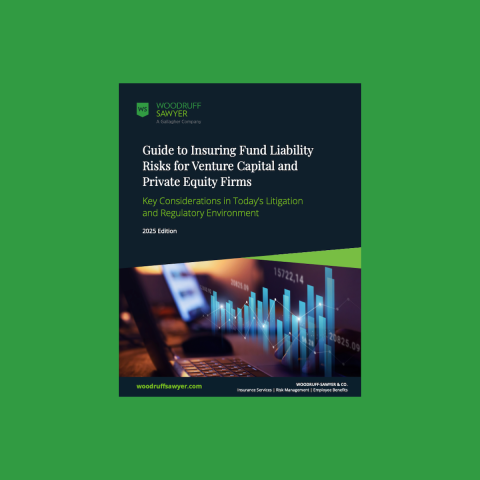Guide
Insuring Fund Liability Risks: A Guide to GPL Coverage for Venture Capital and Private Equity Firms
 Download Resource
Download Resource
In today’s environment, venture capital, private equity, and alternative asset managers must maintain a comprehensive insurance program to protect general partners, directors, and officers from litigation, regulatory scrutiny, and other types of losses. An understanding of core coverage issues is critical not only to mitigate losses impacting the fund's internal rate of return (IRR) but also to the personal assets of the general partners or the management companies themselves.
In Woodruff Sawyer's 2025 Guide to Insuring Fund Liability Risks for Venture Capital and Private Equity Firms, we explore the General Partnership Liability insurance (GPL) landscape. The Guide provides an update on GPL pricing, delves into key coverage and market developments in the GPL ecosystem, and examines the regulatory and litigation risk environment for asset managers in 2025.
Core Issues Affecting GPL Coverage
The Guide discusses two core GPL issues that matter to our clients:
- Pricing vs. Coverage Considerations: While pricing declines are slowing and carriers are under pressure to increase pricing or retentions, it is still a good time to push the envelope on coverage enhancements. Ultimately, insurance is a relationship-driven business, so if you’re looking at a minor difference in premium between an incumbent carrier and a non-incumbent carrier, most brokers will recommend sticking with the incumbent carrier.
- Formal and Informal Investigation Coverage: Many observers expect that technical investigations into asset managers will trend downward, and that regulatory matters will focus more on identifying and penalizing fraud. However, strong GPL coverage can make all the difference if you do get investigated. Small differences in wording can mean the difference between coverage and needing to go out of pocket for expensive defense lawyers' fees. Asset managers need to work with an insurance advisor who can clearly and accurately explain investigations coverage and who can negotiate fiercely and effectively at the claims stage.
Regulatory and Litigation Risk Update
Halfway into 2025, we find ourselves facing a new regulatory landscape. We expect this regulatory and technological uncertainty to continue in the short term, creating headaches for compliance teams planning for the future, and downside risk for portfolio companies unequipped to navigate turbulent markets.
The Guide explores:
- New SEC Captains at the Helm: The new Securities and Exchange Commission (SEC) Chair, Paul Atkins, was confirmed in May. Although it’s still early on in Chairman Atkins’ term, many expect this SEC will have a more constructive and less enforcement-focused approach than past administrations, including on asset manager regulation.
- BSA/AML and Reg S-P Compliance: Perhaps the most significant recent new compliance responsibilities for registered investment advisers come from Bank Secrecy Act/Anti-Money Laundering (BSA/AML) requirements (passed by FinCEN and overseen by the SEC) and Regulation S-P amendments. The Reg S-P amendments seem to be here to stay. On the AML and Customer Identification Program (CIP) rules, interest groups have requested that FinCEN and the SEC reopen the comment period to allow for additional input from industry—we’re still waiting to see if this request will be granted.
Economic Uncertainty and Portfolio Company Risk
In 2025, the economic outlook remains complex for businesses of all sizes. Portfolio company problems—liquidity issues, busted growth stories, accounting improprieties—are key sources of litigation and regulatory enforcement risk for asset managers.
When companies fundraise and scale very quickly, portfolio-level insurance does not always keep pace with the increasing risks that come along with rapid growth. The good news is that, if portfolio company insurance proves inadequate, investors should have another layer of protection in the form of outside directorship coverage in the GPL policy. Talk to your insurance advisor to make sure this coverage is right-sized for your risk; it could be the only thing standing between the firm's (or personal) balance sheets and plaintiffs.
Read the full Guide for more details on GPL coverage and regulatory issues affecting asset managers.
Authors
Table of Contents















